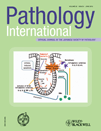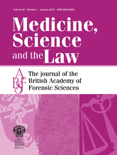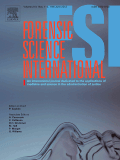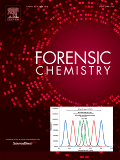
Forensic Science Medicine and Pathology
Scope & Guideline
Innovating the Future of Pathology in Forensic Science
Introduction
Aims and Scopes
- Forensic Pathology and Autopsy Studies:
Focused on the analysis of autopsy findings and their implications in determining cause and manner of death, including case reports that highlight unique or complex cases. - Toxicology and Substance Abuse:
Investigates the effects of various substances on human health, particularly in the context of fatal overdoses and poisonings, contributing to the understanding of drug-related deaths. - Forensic Imaging Techniques:
Explores the use of advanced imaging technologies such as CT and MRI in forensic investigations, enhancing the ability to diagnose and analyze injuries postmortem. - Legal and Ethical Aspects of Forensic Medicine:
Addresses the intersection of law and forensic science, discussing the role of forensic experts in legal proceedings and the ethical considerations in forensic investigations. - Innovative Forensic Methodologies:
Emphasizes the development and application of new methodologies in forensic science, including digital techniques, 3D modeling, and novel analytical methods. - Public Health and Forensic Science:
Examines the broader implications of forensic science on public health issues, such as violence, substance abuse, and the impact of pandemics on forensic practices. - Forensic Anthropology and Odontology:
Investigates the application of anthropological and odontological methods in forensic cases, particularly in identification and age estimation.
Trending and Emerging
- Integration of Artificial Intelligence:
The application of AI in forensic science is increasingly prominent, with studies focusing on its potential to enhance accuracy in identification, analysis, and overall investigative processes. - Impact of COVID-19 on Forensic Practices:
Research addressing the implications of the COVID-19 pandemic on forensic medicine has surged, examining changes in practices, challenges faced by forensic professionals, and the effects on public health. - Forensic Microbiology and Genomics:
The exploration of microbiomes and genomic techniques in forensic investigations is on the rise, providing new avenues for evidence collection and analysis. - Digital Forensics and Cybercrime:
As technology advances, there is a growing emphasis on digital forensics, particularly in relation to cybercrime and its implications for traditional forensic practices. - Environmental Forensics:
The intersection of forensic science with environmental issues is becoming more prominent, focusing on cases related to ecological damage, pollution, and wildlife crimes.
Declining or Waning
- Traditional Forensic Techniques:
Conventional methods of forensic analysis, such as basic histopathology and standard toxicology, are increasingly overshadowed by advancements in technology and more sophisticated approaches. - Focus on Historical Cases:
There has been a noticeable decrease in publications centered on historical forensic cases, as the journal shifts towards contemporary issues and modern forensic challenges. - General Crime Scene Investigation:
The journal has moved away from broad crime scene investigation topics, opting instead for more specialized studies that delve deeply into specific aspects of forensic science. - Suicide and Self-harm Studies:
Research specifically focused on suicide methods and self-harm has seen reduced attention, possibly due to the sensitive nature of the subject and a push towards more constructive public health discussions. - Non-accidental Injury Analysis:
While still relevant, the frequency of studies on non-accidental injuries, particularly in children, appears to be diminishing, potentially due to a shift towards broader public health issues.
Similar Journals

Scandinavian Journal of Forensic Science
Elevating forensic science through collaboration and transparency.The Scandinavian Journal of Forensic Science is a premier open-access journal published by SCIENDO since 2012, dedicated to advancing the field of forensic science. With its ISSN 2353-0707, this journal provides a platform for researchers, professionals, and students to disseminate their findings on various aspects of forensic investigations, including but not limited to forensic biology, chemistry, toxicology, and crime scene analysis. The journal plays a vital role in promoting collaboration and knowledge exchange among forensic practitioners and academics, ensuring that cutting-edge research is accessible to all. As a part of the reputable SCIENDO publishing group, the Scandinavian Journal of Forensic Science upholds high standards of peer review and editorial rigor, making it an essential resource for those involved in the forensic science community. Readers can benefit from its open-access model, which fosters wide dissemination and enhances the visibility of published works, ultimately contributing to the societal impact of forensic research.

PATHOLOGY INTERNATIONAL
Exploring the Depths of Pathological SciencePATHOLOGY INTERNATIONAL, published by WILEY, stands as a distinguished journal in the field of pathology and forensic medicine, serving as an essential resource for researchers, clinicians, and students alike. With its ISSN 1320-5463 and E-ISSN 1440-1827, PATHOLOGY INTERNATIONAL has established itself since its inception in 1951, navigating through an evolving landscape in medical science with insights and breakthroughs up to 2024. It holds a commendable Q2 ranking in both the Medicine (miscellaneous) and Pathology and Forensic Medicine categories, indicating its robust influence and quality within these fields, as evidenced by its placement in the 70th percentile of Scopus rankings. While currently not an open-access journal, it provides access options that ensure valuable research remains available to the academic community. PATHOLOGY INTERNATIONAL commits to advancing the discipline through pioneering research articles, comprehensive reviews, and expert opinions that push the boundaries of understanding in pathology, thereby supporting the enhancement of diagnostic and therapeutic practices.

AJSP-Reviews and Reports
Unlocking Insights for Forensic InvestigationsAJSP-Reviews and Reports is a peer-reviewed journal dedicated to the advancement of knowledge within the field of pathology and forensic medicine. Published by the renowned Lippincott Williams & Wilkins, this journal plays a vital role in disseminating insightful reviews and reports that contribute to the understanding and application of diagnostic practices and forensic investigations. While currently listed in the fourth quartile (Q4) within its category according to the 2023 metrics, the journal is committed to enhancing its impact and fostering scholarly dialogue among researchers, professionals, and students in the medical community. Despite challenges in Scopus rankings, it provides a platform for significant discourse and innovation in pathology. Operating from the United Kingdom, AJSP-Reviews and Reports is positioned to bridge gaps in knowledge and inspire future research developments. Readers can access valuable findings without open access barriers, allowing for efficient information sharing within the medical field.

MEDICINE SCIENCE AND THE LAW
Navigating the Nexus of Health and JusticeMEDICINE SCIENCE AND THE LAW is a prestigious journal published by SAGE PUBLICATIONS INC, focused on the intersection of law, health policy, and ethical issues as they pertain to medicine. With a long-standing history dating back to 1960, this journal has become a crucial platform for scholars and professionals alike to share and disseminate research that shapes the evolving legal landscape surrounding health care practices. It holds notable positions in the academic community, ranking in the Q3 category for Health Policy and Issues, Ethics and Legal Aspects, and achieving a distinguished Q1 ranking in Law as of 2023. With rigorous peer-review standards and a commitment to publishing high-quality research, MEDICINE SCIENCE AND THE LAW is invaluable for those exploring the critical legal challenges and ethical dilemmas faced within the healthcare sector. Research contributions are vital for informing policy and practice, ensuring that the journal remains a relevant and essential resource for researchers, practitioners, and students dedicated to the intersection of law and medicine.

Rechtsmedizin
Transforming Forensic Medicine Through KnowledgeRechtsmedizin is a prestigious academic journal published by Springer, focusing on the critical field of forensic medicine and pathology. With a legacy dating back to 1995, this journal serves as a vital platform for disseminating advanced research and clinical findings that enhance the understanding of legal medicine and forensic science. Although it currently does not offer open access, it boasts an impressive Q3 ranking in 2023 within its category, indicative of its contribution to the field, with a Scopus rank of #149 out of 208 in Medicine, placing it within the 28th percentile of its peers. As a dedicated resource for researchers, professionals, and students, Rechtsmedizin aims to bridge the gap between clinical practice and forensic investigation, promoting the integration of scientific advancements into everyday applications within the legal context. With its location in New York City, USA, the journal remains a key player in the global discourse on forensic issues, thus inviting submissions that push the boundaries of traditional forensic methodologies and explore innovative approaches in legal medicine.

Pathologie
Pioneering Discoveries in Forensic MethodologiesPathologie is a distinguished academic journal published by Springer Heidelberg, dedicated to advancing the field of pathology and forensic medicine. With an ISSN of 2731-7188 and an E-ISSN of 2731-7196, this journal serves as a vital platform for researchers, professionals, and students to disseminate innovative findings and insights. Currently ranked in the Q3 category of pathology and forensic medicine according to the 2023 metrics, Pathologie reflects a commitment to quality and relevance in a dynamic research landscape. Despite its relatively recent establishment from 2022, the journal is gaining traction with a Scopus rank of 139 out of 208 in its category, positioning itself as an emerging resource within the academic community. While it operates under a subscription model, the importance of the journal lies in its objective to facilitate the exploration of diverse pathological processes and enhance forensic methodologies, ultimately improving clinical outcomes and investigative practices. As it continues to grow, Pathologie stands poised to impact the pathology domain significantly.

Forensic Science International
Unveiling Truth through Rigorous ScholarshipForensic Science International is a premier journal published by Elsevier Ireland Ltd, dedicated to advancing the field of forensic science through interdisciplinary research and scholarship. Since its inception in 1978, this esteemed journal has provided a platform for vital research, receiving recognition in the Q1 category for both Law and Pathology and Forensic Medicine as of 2023, underscoring its significant impact in these domains. It currently ranks 54th out of 1025 journals in Social Sciences - Law and 51st out of 208 in Medicine - Pathology and Forensic Medicine, placing it in the top echelons of academic journals according to Scopus metrics. Forensic Science International transitioned to Open Access in 2019, ensuring that critical findings are widely available to the global research community and enhancing collaboration among forensic professionals. With a forward-looking scope that evolves to meet the challenges and innovations of forensic science, this journal remains a pivotal resource for researchers, practitioners, and students who are committed to the continued advancement of forensic science and its applications in legal contexts.

Journal of Forensic and Legal Medicine
Bridging Disciplines for Better Legal Outcomes.The Journal of Forensic and Legal Medicine, published by Elsevier, stands at the forefront of interdisciplinary research in the overlapping domains of law, medicine, and forensic science. With an ISSN of 1752-928X and an E-ISSN of 1532-2009, this esteemed journal covers pivotal advancements in the field, spanning from 2007 to 2024. The journal enjoys a distinguished reputation, evidenced by its Q1 ranking in Law and its notable positions in the Scopus Ranks with an 82nd percentile in Social Sciences—Law. As a crucial resource for researchers, practitioners, and students alike, the journal focuses on the vital role of forensic evidence in legal contexts, ensuring the dissemination of high-quality, peer-reviewed articles that contribute to both academic and practical applications in the realm of forensic and legal medicine. Its accessibility to a broad audience, despite not being open access, bolsters its importance in advancing forensic science, policy-making, and medical jurisprudence worldwide.

PATHOLOGICA
Advancing the Frontiers of Pathology and Forensic Medicine.PATHOLOGICA is a leading academic journal dedicated to the field of pathology and forensic medicine, published by PACINI EDITORE. With a rich history dating back to its inception in 1945, the journal has consistently contributed to the advancement of knowledge in these vital areas of medical research and practice. Currently ranked in the Q1 quartile for Pathology and Forensic Medicine and holding an impressive position as #42 out of 208 in the Scopus rankings, it reflects a significant impact within the academic community, boasting an 80th percentile ranking. The journal is committed to publishing high-quality, peer-reviewed articles that explore innovative research findings and clinical advancements, making it an essential resource for researchers, clinicians, and students alike. Though it does not offer open access, PATHOLOGICA continues to foster scholarly communication by disseminating cutting-edge research findings, thus playing a pivotal role in enhancing pathology education and practice worldwide.

Forensic Chemistry
Empowering forensic investigations with analytical precision.Forensic Chemistry is a premier journal published by Elsevier, specializing in the interdisciplinary field of forensic science, with a strong emphasis on analytical and materials chemistry, pathology, and law. Established in 2016 and converging to a significant publication trajectory through 2024, the journal has rapidly ascended to an impressive Q1 ranking across multiple categories, demonstrating its impact and commitment to advancing forensic analysis and methodologies. With an impact factor reflecting its relevance—especially notable with a 95th percentile rank in Social Sciences and Law—Forensic Chemistry serves as an essential resource for researchers, legal authorities, and academics seeking to explore the latest developments in forensic techniques and applications. Its rigorous peer-review process and high-quality publications ensure that it remains at the forefront of scientific inquiry in forensic practices. Access to the journal is available without an open access model, further emphasizing its commitment to curated, high-impact scholarship that contributes to both theoretical foundations and practical applications in the forensic field.